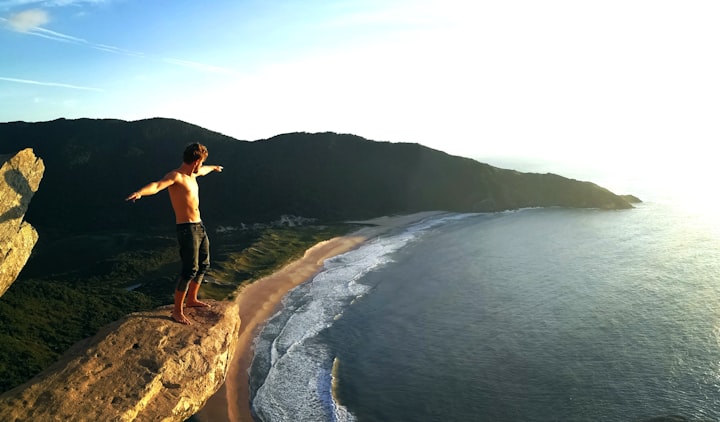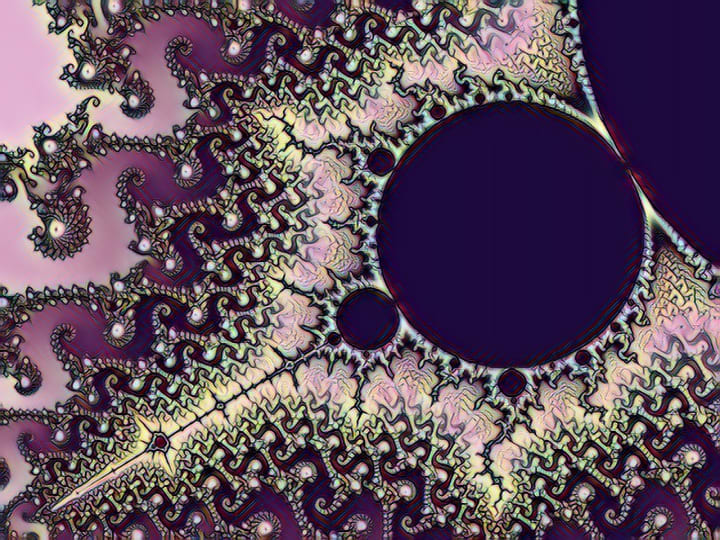
You walk on a line between this and that, the line moves in an undulating pattern, but you continue your journey. You follow the line. You walk on the knife’s edge. You travel between the profound and the ridiculous, between humor and sadness, between wisdom and insanity. You walk the fractal line.
Why travel this path? It is not a safe place, people on either side of the argument will tell you that you are wrong, and you could fall off the line in a direction you don’t want to go. You could fall into the ridiculous, into sadness or into madness. Why risk it?
Because, there is power in walking the fractal line.
Fractals are traces, tracks, marks or forms made by a chaotic system. They don’t have to divide one thing from another but they often do, and where they do new things happen. A place marked by chaos that is often the place between two different things is what we will call the fractal line for the short deration of this article.
To see the power in the fractal line, you can first look to the natural world. In nature, life abounds and is more diverse where the water meets the land. Go to a coast, to an estuary, to a watering hole and you will be gifted with a bountiful display of nature’s many muses. Life is more creative, showing up in more shapes and sizes, in more inspirations in that fractal place between things.
The man who coined the term fractal, Benoit Mandelbrot, thought of beaches when he asked a simple question: How long is Britain’s coast? The answer seems simple enough, measure the coast by the map and you have your answer. But what if you get a better map, which shows more dips and curves? Then the coast gets longer with each dip and curve. And what if you get a better map, and a better map, all the way down to a map of atoms of the coastline? The conclusion Mandelbrot came to is that the coast of Britain, the United States and the circumference of your local pond is infinite. So as you walk this fractal line realize that, if you wanted it to, this journey could be infinite. Like Alice down the rabbit hole, you could fall farther and farther into the world of detail. There is power in the idea that there is infinite detail on the line between things, if you look. You can invest in understanding the detail, or you can ignore it, but there is power in knowing it is there.
There is also power in knowing that a chaotic system, like the waves of the ocean, the roots of a tree, or the movements in markets are fractal; self-similar, meaning component parts resemble the whole. So if you are trying to understand something that is large and unwieldy, something that is touched by many forces, touched by chaos, study a smaller part of it and see if it applies to the larger part. In a truly chaotic system, this will not be an exact match, but a smaller part will resemble the whole.
A fractal is a line, track or mark created by a chaotic system, but it is not a straight line. It is a wrinkle and in that wrinkle it has power; power not to be measured, power to be infinite in its wrinkly detail. If you crumple a piece of paper, how many surfaces does it have? Is it a plane or three-dimensional object? In these modern times a certain uniformity may be seen as powerful, but the fractal line says that the more different you are the harder you are to catch, quantify, and tame. Embrace the wrinkles, the kinks, the deviations from that straight line or flat plane; they literally give you more room to grow.

If you bring your computer onto the fractal line and google “fractal” you will more than likely come across beautiful abstract drawings in repeating patterns, which are generated by a computer often using the Mandelbrot set. These images are mathematical formulas plotted out, with the equation’s results fed back into the equation. Nature can’t be so exact because there are too many inputs. If you have ever felt that a digital mountain range or landscape in a movie or video game is a bit off, that is because your mind is seeing the exact pattern of the fractal. In nature the pattern would be softer, holding more mystery in its complexity, because it has an almost infinite amount of inputs. There is power in seeing the difference between mechanical fractals and natural fractals. When we are walking on the fractal line we are not walking inside an equation, but inside the mystery of how everything is connected in this chaotic system of life. We should not throw away the mystery locked within the fractals of the natural world just because we have made ambitious but imperfect attempts to recreate them.
Somewhere on this fractal line is a tree. From the DNA in its seed to the splitting of its roots and branches in a repeated pattern, the tree is a perfect example of a growing fractal. In a fractal there is order, but that order is acted upon by a chaotic system. The amount of water, type of soil, where the tree is planted makes the tree unique, but it is still a part of the greater whole from which it grew. We too are part of the greater story of the world, not just the human story. In Seven Life Lessons of Chaos: Spiritual Wisdom for the Science of Change by John Briggs and F. David Peat they explain how a human “fetus passes through resemblances of a fish, an amphibian, and other mammals, traversing a microhistory of the chaos of evolution until it finds its own form and face.” Standing on the fractal line, when we look up into the detail of the stars, look down into the detail of the roots, or look inside into the detail of ourselves, we see reflections of the greater world.
As it goes in the outer world so it goes in the inner world. We live in our minds. That is the place we exist and often we are between two different emotions, two different ideas, or two (or more) different belief systems. It is powerful to acknowledge the importance of that line between. Emotions, values, ideas, cultural norms, and different sets of moralities pull on us in such a chaotic way, just like an ocean pushes and pulls on the coast. To stand on the line between them, is to stand in that infinite place that is not defined. When your emotions are washing over you and you are feeling both happiness and sadness, or anger and the desire to forgive, try and hold the line. Try and stand in that place that is between. You don’t have to be there forever, but see what it has to teach you. It might be more powerful to stay there. The power of the fractal line is that you don’t have to force yourself to choose. Historically we have been told that we need to decide between things, that we should not stand on that fractal line, but there is a new consciousness, a nonbinary consciousness, that sees the power in wanting to stand in the place that is both and neither, that is infinite in its ability to walk the line between things.
Time too can be fractal, if you are willing to set aside the consumerist idea of perfectly quantified and linear time. Have you noticed how long certain moments can take, and in other cases how fast time can go? If you allow your mind to think there can be fast-time and slow-time, then you have fractal time. Once your perception of time becomes more fluid, you can play with it, change its pace. One way to slow time down is to pay attention more to things and events you encounter as you move through your day. It is now theorized by many psychologists that our minds perceive time not as a ticking clock but instead, by the inputs we take in, that is the things we notice. If you want to savor time, like during a vacation, make a conscious effort to notice the details around you. To make time go faster, routine is the key. Lifetimes have passed in what seems like the blink of an eye because a routine was settled into and not questioned. There is power in knowing you can bend time or straighten it out. In the same way we can look at more and more detail on a coastline, we can look closer and closer at the landscape of our lives. This examination literally gives us the feeling of gaining time.
We can not only play with the speed of time, we can improve the quality of time. We can apply the theme of fractals being self-similar to how we build our days. If we are having trouble with our interior landscape with doubt, anger, or other hard feelings, or we just want to make improvements like mindfulness, gratitude, better eating and more exercise, it can be helpful to create one perfect moment, then minute, then hour, then day. In trying to redraw the small, we can redraw the larger.
When you are feeling the pull of opposing forces from outside or from within, imagine yourself walking along the beach. The waves roll up, covering your toes and then roll back down again. In the distance is a beautiful tree. You can see the pattern of the branches against the sky and know that same pattern is bellow drawn in roots in dirt. This is a place you can go inside your mind, the place between things. It is infinite. It is yours. You can draw power from this place. You can travel here anytime and stay as long as you like.
About the Creator
Man Munin
Man Munin is an artist walking that fractal line between the profound and the ridiculous. She is the and author of The American Grimoire, The Otherworld Comic Book and The Bear and the Bird: a tale told about love, all available on Amazon.






Comments
There are no comments for this story
Be the first to respond and start the conversation.